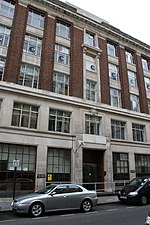Bolsover Street

Bolsover Street is in the Parish of St Marylebone in London’s West End. In administrative terms it lies within the City of Westminster's Marylebone High Street Ward and is partly in the Harley Street Conservation Area whilst also sitting on the edges of the Regents Park and East Marylebone Conservation Areas.The predominant land use on Bolsover Street is office business use, mixed with hotels (and YHA Hostel), medical and professional activity. Numerous communications, new media and broadcast entities are located in offices on the street. Residential presence on the street is strongest at its northern and closest end to Regent's Park and Regent's Place. The Royal National Orthopaedic Hospital has been present on the street since 1907.
Excerpt from the Wikipedia article Bolsover Street (License: CC BY-SA 3.0, Authors, Images).Bolsover Street
Bolsover Street, City of Westminster Fitzrovia
Geographical coordinates (GPS) Address Nearby Places Show on map
Geographical coordinates (GPS)
| Latitude | Longitude |
|---|---|
| N 51.522027777778 ° | E -0.14294444444444 ° |
Address
Bolsover Street
W1W 5DE City of Westminster, Fitzrovia
England, United Kingdom
Open on Google Maps









